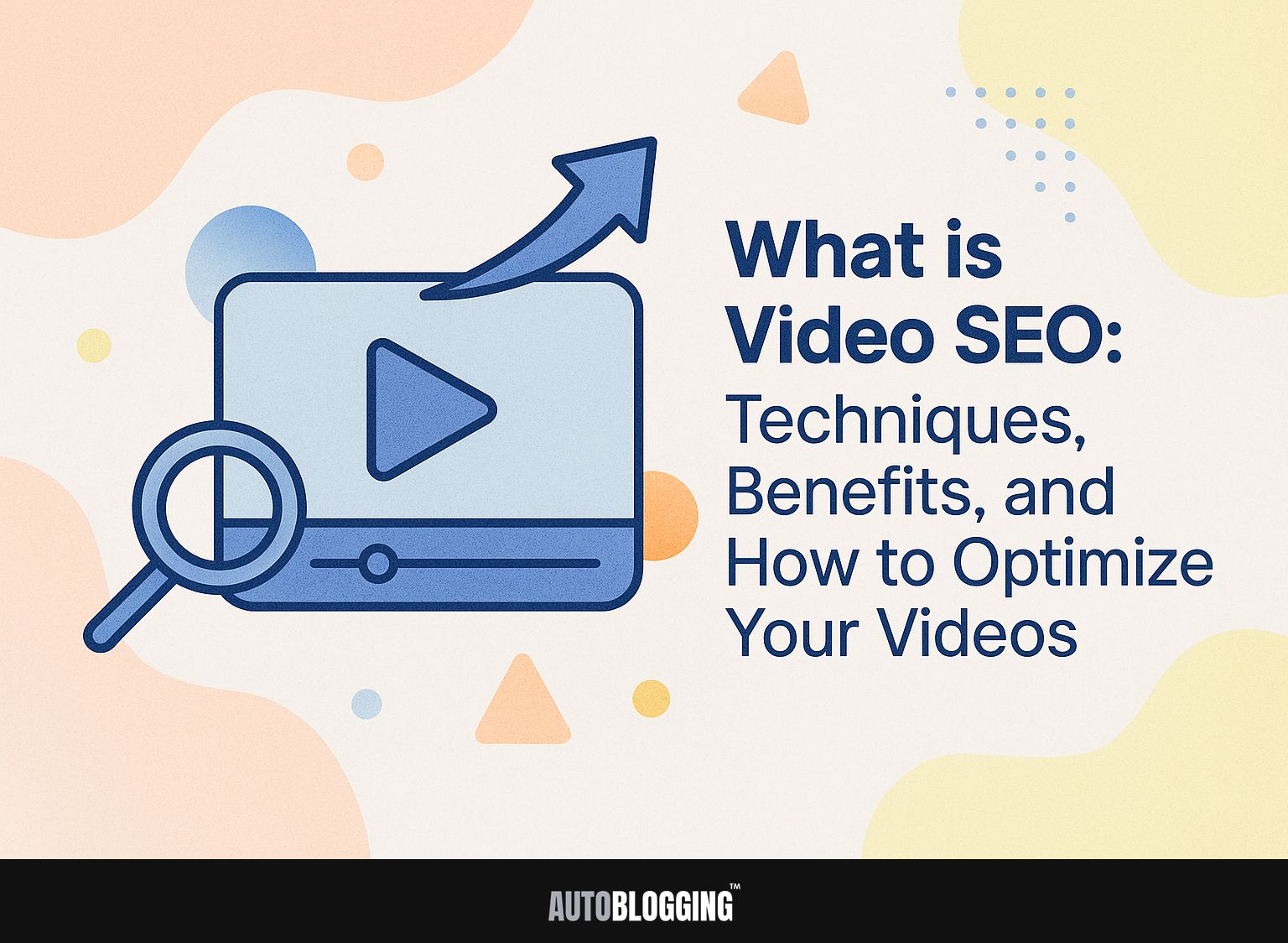
Do you want to increase your visibility online? Improving Video SEO helps your video content rank better on Google and draws in viewers looking for particular videos. Platforms like YouTube and tools such as Semrush highlight the growing importance of effective video optimization. In this article, we’ll look at reliable methods and the advantages of video SEO, guiding you to make interesting content that grabs attention in a crowded market.
Key Takeaways:
- Video SEO involves improving videos so they show up more easily and rank better on search engines. This makes them a key part of online marketing plans.
- Effective video SEO methods involve doing keyword research, improving titles, descriptions, tags, and thumbnails, and thinking about video length to catch the interest of viewers.
- The advantages of video SEO are that it helps more people find you on search engines, keeps viewers interested longer, makes your brand more recognizable, and improves how users interact with your site. It is a useful tool for businesses to share their content and products.
Contents
- Techniques for Video SEO
- Benefits of Video SEO
- How to Optimize Your Videos
- Common Mistakes to Avoid in Video SEO
- Frequently Asked Questions
- 1. What is Video SEO and why is it important?
- 2. What are the benefits of using Video SEO?
- 3. How can you improve the visibility of your videos in search results?
- 4. How can I track the success of my Video SEO efforts?
- 5. Do you have any more tips for improving video SEO?
- 6. What are some typical errors to avoid when improving videos for SEO?
1. Definition of Video SEO
Video SEO involves methods to make video content more visible on search engines and increase user interaction.
Important strategies include improving keywords, writing interesting video descriptions, and creating attention-grabbing thumbnails.
For keyword research, tools like Google Keyword Planner can help identify popular search terms related to your video’s topic. Writing a detailed description using important keywords helps search engines understand and index the content better.
Thumbnails should be eye-catching and match the content because they greatly affect how often people click on them. Trying out different thumbnails and descriptions in A/B tests can improve your strategy, resulting in more views and better engagement over time.
2. Importance in Digital Marketing
With 88% of marketers claiming video content provides a positive ROI, its importance in digital marketing cannot be overstated.
People remember 95% of a message when they watch a video, compared to reading it. About 80% of people choose to watch a video instead of reading text, which leads to higher conversion rates.
For example, The Verge used video in their product reviews, leading to a large increase in audience interest and shares.
To make the most of this opportunity, marketers can use tools like Animoto for fast video creation or Vidyard for tracking video performance. Curious about how Google Gemini could enhance your video marketing strategy? Our article explains the innovative features.
Investing in video content is no longer optional; it’s essential for achieving marketing success.
Techniques for Video SEO
Good video SEO methods can greatly improve how often people see and interact with your content. This approach aligns with the strategies discussed in our exploration of AI-Driven SEO, which highlights innovative techniques that enhance visibility and engagement.
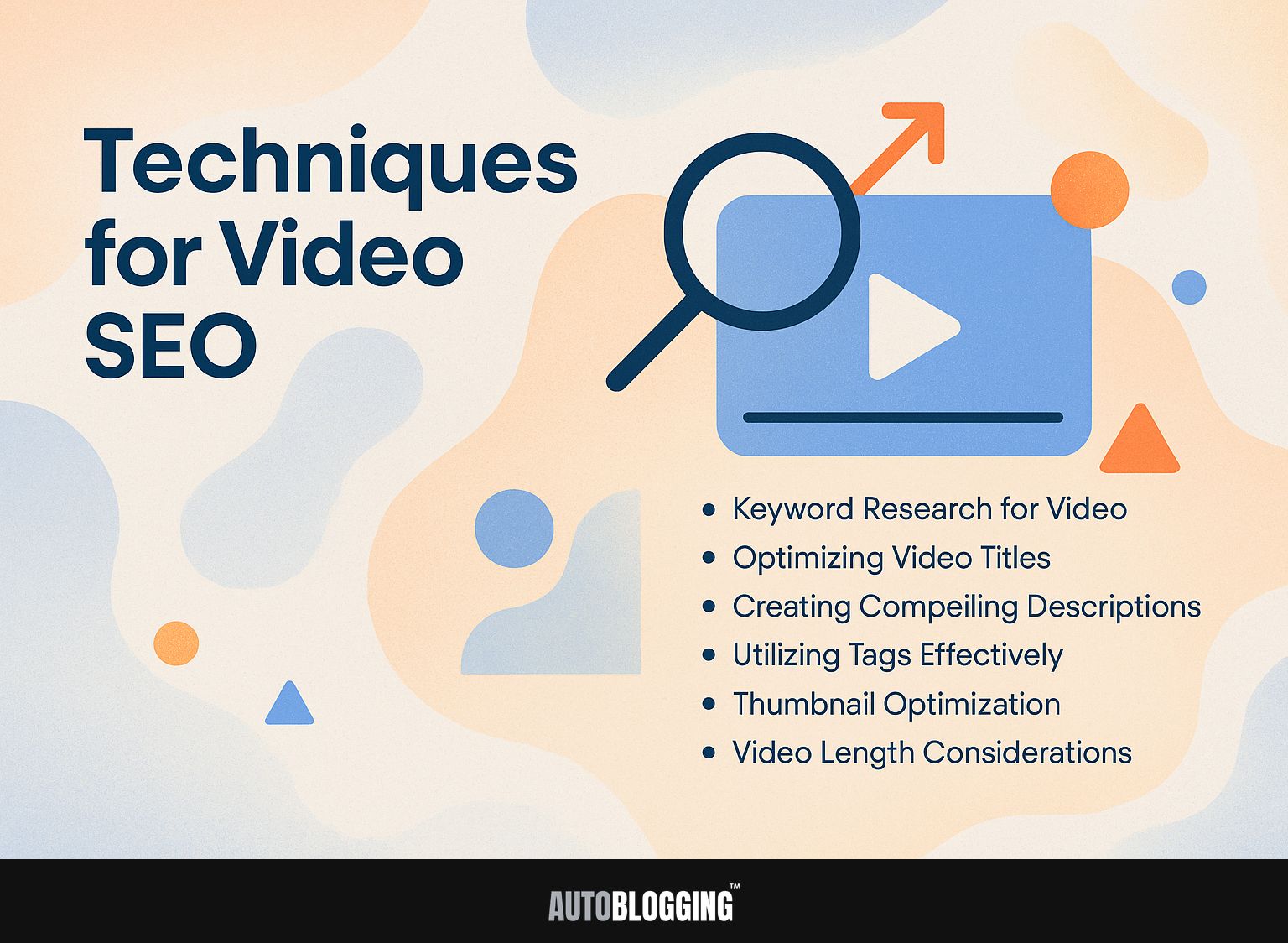
1. Keyword Research for Video
Using tools like Ahrefs and Google Keyword Planner can improve your keyword research, showing what terms are popular with your audience.
Begin by identifying your target audience. For instance, if you create cooking videos, think about age, interests, and cooking skill levels.
Next, analyze competitor keywords through Ahrefs to see which terms drive traffic to their video content. Choose keywords that are popular but have less competition, like “easy vegan recipes for beginners.” This approach helps bring in viewers and makes your content noticeable in search results.
Regularly revisiting and adjusting your keyword strategy keeps your content relevant and engaging.
2. Optimizing Video Titles
Creating strong video titles with specific keywords can raise click-through rates by more than 30%. To improve your titles effectively, follow these steps:
- Start by adding main keywords that connect with your content and audience.
- Try to keep titles under 60 characters so they show completely in search results.
- Make people interested; for example, instead of ‘How to Bake Bread,’ use ‘Learn the Steps to Perfect Bread.’
- Popular videos like ‘Top 10 Travel Destinations You Must See’ exemplify this strategy by combining intrigue with essential keywords, driving higher engagement.
3. Creating Compelling Descriptions
Writing a good video description can help with search rankings and keep viewers watching longer, particularly when using relevant keywords.
To create engaging video descriptions, follow these steps:
- Begin with an engaging overview of what the video covers, ensuring it fits within 200-300 words.
- Place the main keywords smoothly within the first 150 words to improve SEO.
- Organize your information using headings or bullet points for easy reading.
- Include a strong call-to-action (CTA) at the end, such as “Subscribe for more tips!” or “Leave a comment below!”
An effective template might look like this:
- Introduction (1-2 sentences about the video)
- Key points or segments (use bullet points if needed)
- Suggestions to subscribe, leave a comment, or check out related content
By carefully writing your descriptions, you make it easier for others to find your content and motivate them to engage with it.
4. Utilizing Tags Effectively
Using 5-8 specific tags can help sort your video content, making it easier for people to find on platforms like YouTube.
These tags should include both general keywords, such as ‘cooking tips’, and specific phrases like ’30-minute dinner recipes’ to cover a broad audience.
For instance, the video ‘Easy Vegan Dinners in Under 30 Minutes’ gained significant visibility by using targeted tags like ‘vegan recipes’, ‘quick meals’, and ‘easy dinner ideas’.
By analyzing trending tags in your niche using tools like TubeBuddy or VidIQ, you can maximize your video’s reach and engagement, ensuring it reaches the right viewers and climbs the search rankings.
5. Thumbnail Optimization
An effective thumbnail can increase the number of clicks by as much as 154%, making it an important factor in video SEO.
To create useful thumbnails, use clear images that match your content well. Choose easy-to-read fonts-strong styles are effective-and make sure contrasting colors increase visibility.
Canva offers simple drag-and-drop tools for customization, making it suitable for beginners in design. Adobe Spark offers templates specifically designed for different platforms, simplifying the task for experienced users.
Think about adding branding elements, like your logo, to help people recognize your brand and create a consistent look for all your videos.
6. Video Length Considerations
Research suggests that videos between 7-15 minutes perform best for engagement and retention across various platforms.
To make your video length better, think about who will watch it and what kind of content it is. Educational videos are usually better when they are longer to cover topics thoroughly, while entertainment content can be shorter and more concise.
For accessibility and to improve watch time, use tools like Rev for transcription, allowing viewers to follow along easily or engage in sound-off scenarios.
Analyze your previous video performance; look for trends in audience drop-off points to fine-tune length and pacing. Finding the right balance with these factors can greatly improve how viewers enjoy the content and keep them watching.
Benefits of Video SEO
Using effective video SEO strategies results in many advantages, such as increased visibility and improved engagement metrics. These benefits are quite similar to those seen in other SEO practices. For instance, our guide on off-page SEO strategies explores additional ways to enhance your online presence beyond video SEO.
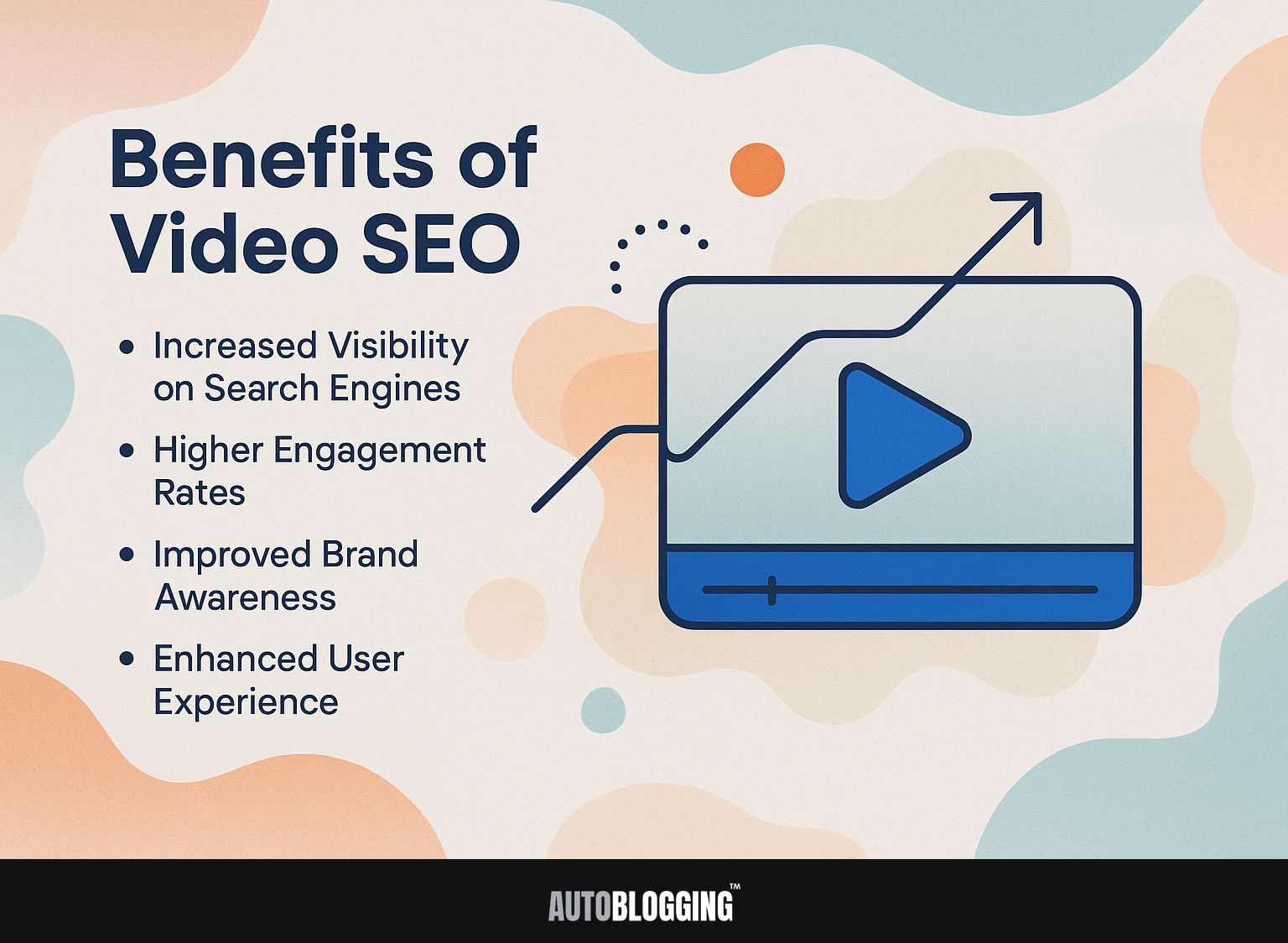
1. Increased Visibility on Search Engines
Videos that are made better can appear on the first page of Google, where 70% of the results on that page have video content.
To improve video SEO, concentrate on clear strategies. Start by using tools like Google Keyword Planner or Ahrefs to find helpful search terms.
Use these keywords in your video title, description, and tags. For instance, a cooking channel may target ‘quick pasta recipes,’ leading to better visibility.
Creating engaging thumbnails and adding closed captions can also improve click-through rates. Get viewers to like and comment on your video to improve its position in search results, as these actions are important for being seen.
2. Higher Engagement Rates
Videos on landing pages can increase conversion rates by up to 80%, highlighting their role in engagement.
For best results, brands should focus on key strategies.
- First, use short, engaging video snippets-less than 60 seconds-to capture attention quickly. For example, Dropbox increased conversions by featuring a 1-minute explainer video, showcasing their service effectively.
- Using testimonials can make the brand feel more relatable; Glossier used customer videos to build trust, resulting in a 50% rise in user interactions.
- Using analytics tools like Google Analytics can improve video performance by monitoring where viewers stop watching and how they interact with the content, enabling changes based on data.
3. Improved Brand Awareness
Video content can increase brand awareness by 70% when used strategically across platforms like Facebook and Instagram.
Brands like GoPro and Dollar Shave Club exemplify the power of video marketing. GoPro’s campaign showcased user-created videos of thrilling events, raising brand recognition and driving more sales.
Similarly, Dollar Shave Club’s humorous launch video went viral, gaining over 12,000 new subscribers in 48 hours.
To use this for your brand, make interesting video content that shows the advantages of your product and gets users to engage. Tools like Adobe Premiere Rush can simplify editing, while platforms like Canva offer templates for quick social media videos. Consistency and creativity are key.
4. Enhanced User Experience
Videos make user experience better by offering useful content in a way that holds interest, causing people to stay on the site longer.
Websites like BuzzFeed and Airbnb have successfully integrated video to capture user attention. BuzzFeed uses brief and interesting videos alongside articles to keep viewers both amused and knowledgeable at the same time.
Airbnb showcases stunning property videos on listings, enabling potential guests to visualize their stay. To implement this on your site, consider using tools like:
- Wistia for video hosting
- Vidyard for custom video marketing
Aim for videos that are concise and relevant, ideally between 30 seconds and two minutes, to maintain viewer engagement.
How to Optimize Your Videos
Improving your video content requires careful decisions about where to share, how to embed, and how to spread it across different channels.
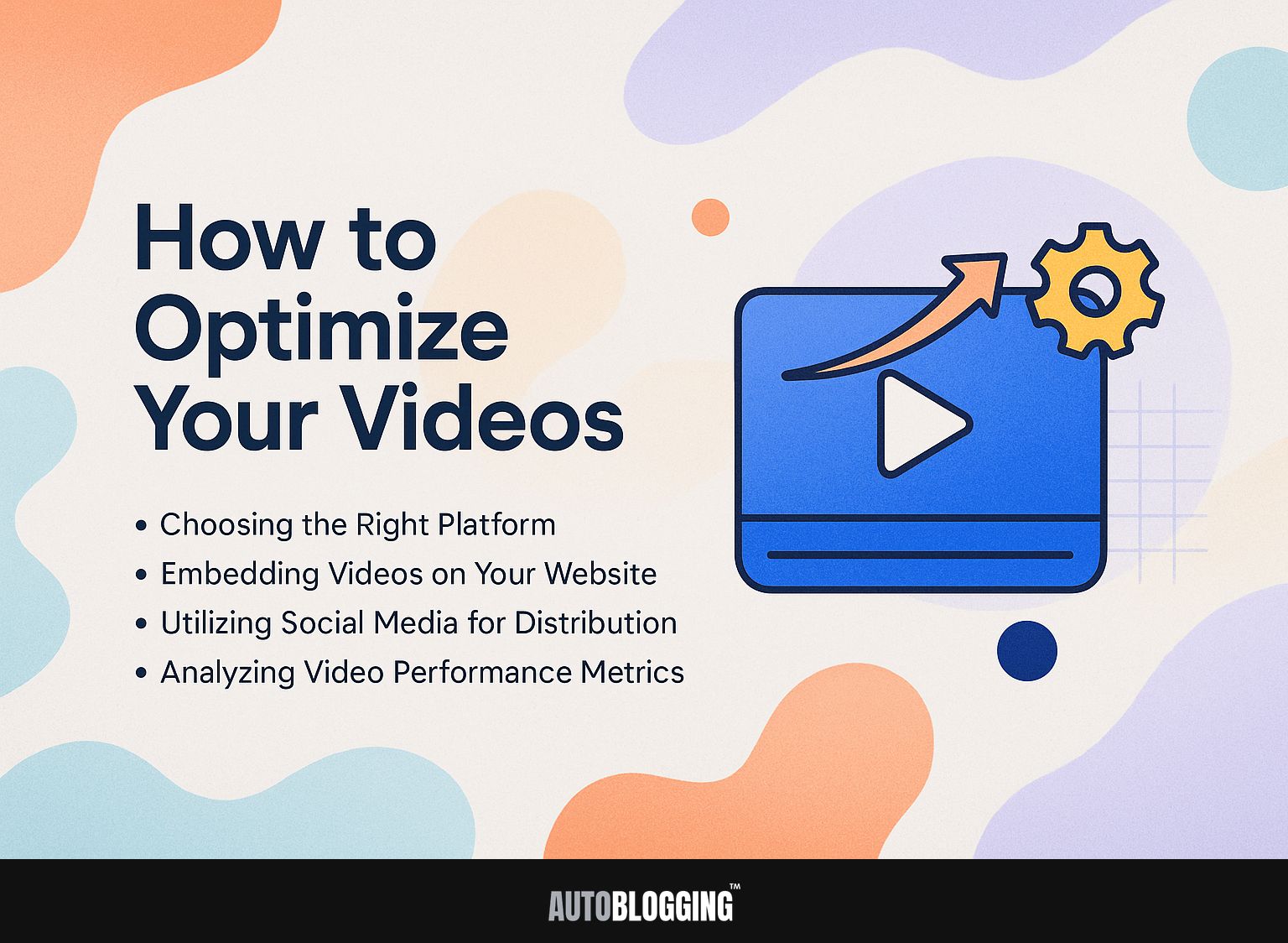
1. Choosing the Right Platform
Choosing the right platform is important; YouTube works well for long-lasting content, while TikTok is better for quick, popular clips.
When choosing a platform, consider your target audience and content type. YouTube is excellent for detailed tutorials and product reviews, making it perfect for companies wanting to produce many videos.
In contrast, TikTok is designed for short, powerful messages, perfect for engaging younger audiences. Instagram serves well for visually appealing content, such as fashion or food, and allows for engaging storytelling through Stories and IGTV.
Evaluate your objectives-whether brand awareness, engagement, or traffic-and select the platform that aligns best with your content strategy.
2. Embedding Videos on Your Website
Embedding videos on your website can increase session duration by 70%, enhancing SEO performance.
To effectively embed videos, use platforms like YouTube or Vimeo, which offer user-friendly embedding options. Place videos above the fold, ensuring they’re visible without scrolling, to capture immediate attention.
For size, choose a width of 560 pixels for regular screens, ensuring they work well on mobile devices. Tools like Elementor can simplify this process with drag-and-drop functionality.
Use relevant keywords in video titles and descriptions to increase how often they appear in search results. These methods help engage users more and improve SEO outcomes.
3. Utilizing Social Media for Distribution
Using social media can increase the number of people who see your videos, as posts with videos get 48% more views.
To maximize visibility, consider posting at peak engagement times: typically, weekdays between 10 a.m. and 1 p.m. for Facebook, and around 11 a.m. on Instagram and Twitter.
Customize your captions for each platform. On Facebook, ask interesting questions to get more comments. On Twitter, use popular hashtags to reach more people.
Use tools like Hootsuite or Buffer to plan your posts, keeping your updates regular. Cross-promote your videos by embedding them in blogs or sharing snippets on TikTok to draw your audience from various channels.
4. Analyzing Video Performance Metrics
Regularly checking important performance numbers like how long people watch and how often they interact is important for continued video SEO success.
To improve your video content, concentrate on particular measurements using tools like YouTube Analytics.
Start by monitoring your Click-Through Rate (CTR); a low CTR indicates your thumbnails or titles may need improvement. Next, assess the Average View Duration to determine if your content is holding viewers’ attention-consider adjusting your pacing or incorporating engaging graphics.
Monitor how long viewers stay engaged with your videos to identify when they lose interest, helping you improve upcoming content. Follow these steps regularly to improve your video performance and increase viewer interaction.
Common Mistakes to Avoid in Video SEO
Avoiding common mistakes in video SEO can significantly improve how well your content performs and how easily it is found.
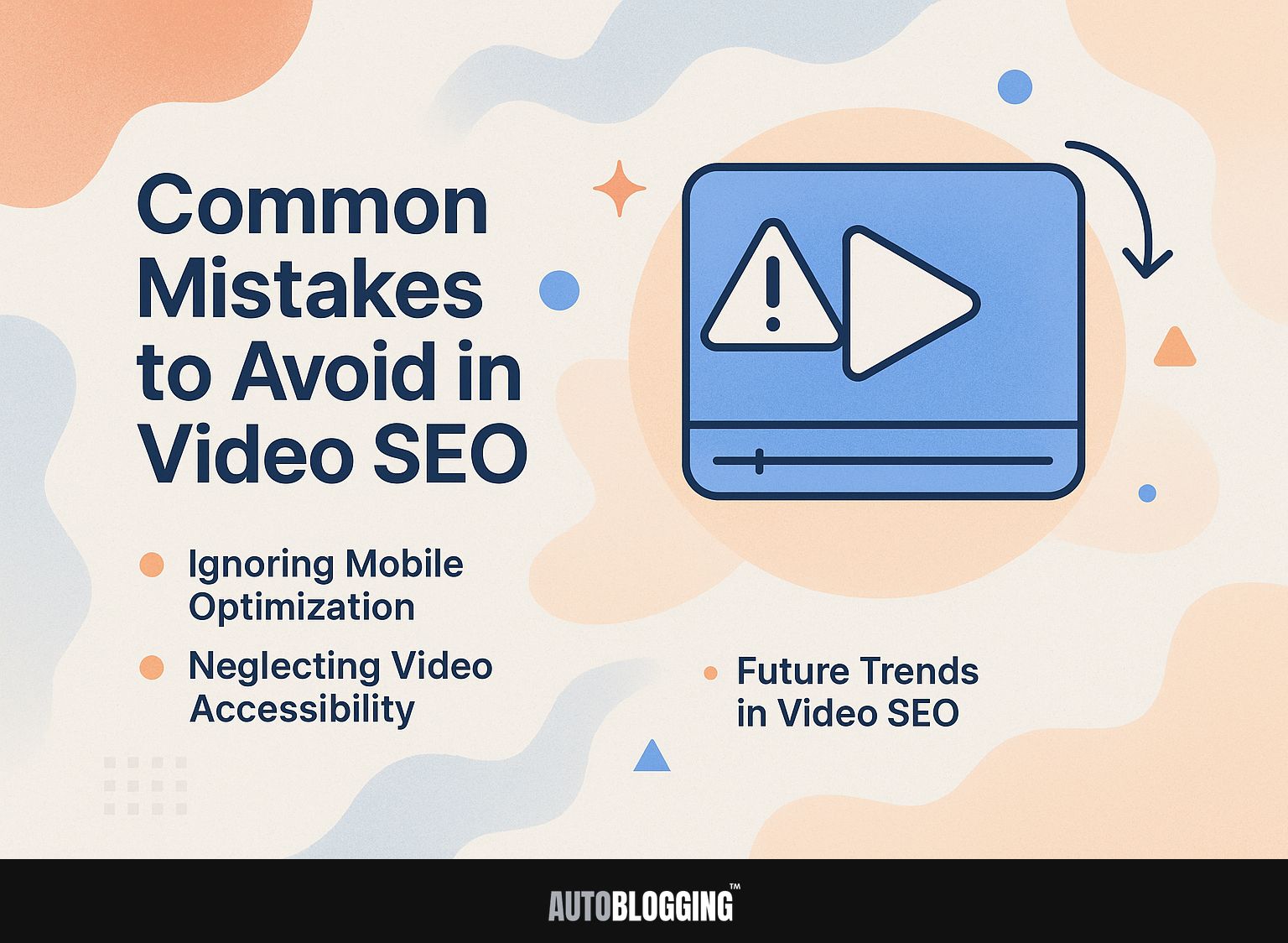
1. Ignoring Mobile Optimization
With over 60% of video views occurring on mobile devices, neglecting mobile optimization can significantly hinder performance.
To make sure your video content works well on mobile devices, begin by using design methods that adjust to different screen sizes. Tools like Adobe Premiere Pro and Final Cut Pro offer features that automatically adjust video dimensions to fit various screen sizes.
Use the Google Mobile-Friendly Test to check how your videos perform across devices. Make sure to test your videos on different phones and tablets, including iPhones and Android devices, to find any problems with playback or layout differences.
Make sure your videos load quickly by reducing their file size with tools like HandBrake or Clipchamp. This will maintain the video quality while allowing them to load more quickly.
2. Neglecting Video Accessibility
Failing to address video accessibility can alienate a significant portion of your audience, impacting engagement.
Adding captions and transcripts makes it easier for viewers who are deaf or hard of hearing to understand, as well as for people in places where sound is restricted.
Rev provides high-quality captioning services, and Temi offers a cheaper choice for machine-based transcription. These features make your content easier for more people to access and improve search engine visibility, making it easier to find.
To get started, simply upload your video to these platforms, customize your captions as needed, and embed them back into your video before publishing.
3. Future Trends in Video SEO
The progress in AI and machine learning will shape how we improve and share video content for better search visibility.
To keep up with changes, creators should look at tools like VidIQ, which checks keywords and tags, or TubeBuddy, which gives information on competitor strategies.
Using short videos on platforms like TikTok and Instagram can increase interaction, as they are becoming more popular with users.
Focusing on improving metadata-such as creating interesting thumbnails and descriptions-will continue to be important.
By using these new strategies, content creators can get more views and improve discoverability for their videos, tapping into the rising interest in upcoming video trends. Related insight: Google’s AI training on YouTube’s vast content library offers a unique perspective on leveraging AI in content creation.
Frequently Asked Questions
1. What is Video SEO and why is it important?
Video SEO, or Video Search Engine Optimization, means the methods used to make videos more visible on search engines. This includes using keywords, relevant titles and descriptions, and other strategies to improve the visibility and ranking of videos in search engine results. This matters because it can help more people find and watch your videos.
2. What are the benefits of using Video SEO?
Some advantages of using Video SEO include:
- Higher video ranking in search engine results
- Increased visibility and exposure for your videos
- Improved chances of reaching and engaging with your target audience
- Potential for higher website traffic and conversions
- Opportunity to stand out from competitors in search results
3. How can you improve the visibility of your videos in search results?
Some methods to improve your videos for search engines include:
- Using targeted keywords in video titles, descriptions, and tags
- Including relevant and engaging thumbnails
- Adding closed captions and transcripts for accessibility and better search engine indexing
- Promoting your videos on social media and other platforms
- Creating high-quality, informative, and engaging content
4. How can I track the success of my Video SEO efforts?
To track the success of your Video SEO efforts, you can use tools such as Google Analytics to monitor your website traffic and the performance of your videos. You can also track the number of views, likes, comments, and shares on your videos on various platforms. Also, keep an eye on how your video ranks in search engine results and change your Video SEO plan as needed.
5. Do you have any more tips for improving video SEO?
Here are more tips for improving the SEO of your videos:
- Including a call-to-action at the end of your videos to encourage viewers to engage or visit your website
- Utilizing relevant and popular hashtags in your video descriptions and social media posts
- Keeping your videos short and engaging to hold viewer’s attention
- Collaborating with influencers or other content creators to increase visibility and reach
- Regularly monitoring and updating your Video SEO strategy based on current trends and algorithms.
6. What are some typical errors to avoid when improving videos for SEO?
Here are some typical errors to steer clear of when improving videos for SEO:
- Using generic or irrelevant titles and descriptions
- Ignoring the importance of keywords and tags
- Not promoting your videos on multiple platforms
- Creating low-quality content
- Neglecting to improve for mobile devices
- Not tracking and analyzing the performance of your videos
